What France is Doing.
Page 8
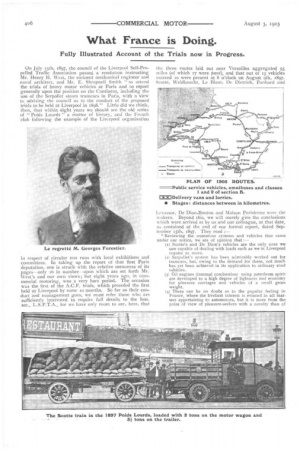
Page 9

Page 10

Page 11
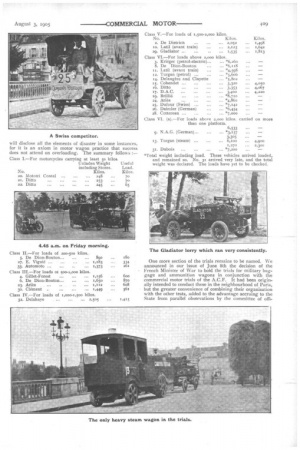
Page 12
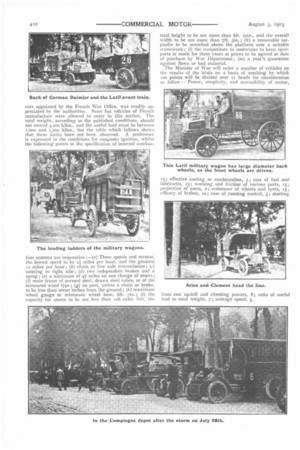
Page 13

Page 14
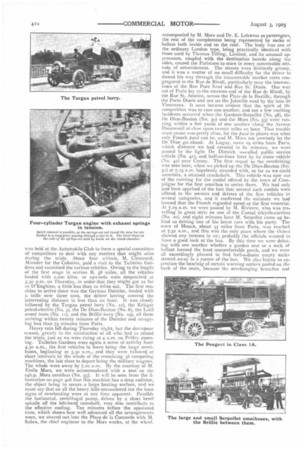
Page 15
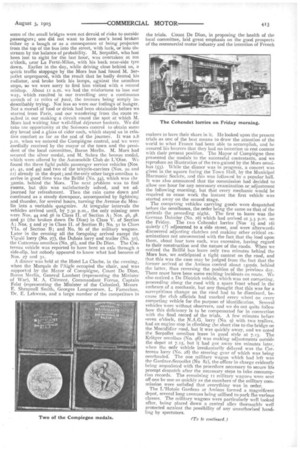
If you've noticed an error in this article please click here to report it so we can fix it.
Fully Illustrated Account of the Trials now in Progress.
On July 13th, 1897, the council of the Liverpool Self-Propelled Traffic Association passed a resolution instructing Mr. Henry H. West, the eminent mechanical engineer and naval architect, and Mr. E. Shrapnel] Smith " to attend the trials of heavy motor vehicles at Paris and to report generally upon the position on the Continent, including the use of the Serpollet steam tramcars in Paris, with a view to advising the council as to the conduct of the proposed trials to be held at Liverpool in 1898." Little did we think, then, that within eight years we should see the old series of " Poids Lourds " a matter of history, and the French club following the example of the Liverpool organisation
in respect of circular test runs with local exhibitions and committees. In taking up the report of that first Paris deputation, one is struck with the relative meanness of its pages—only i6 in number--upon which are set forth Mr. West's and our own views; but eight years ago, in commercial motoring, was a very bare period. The occasion was the first of the A.C.F, trials, which preceded the first held at Liverpool by some to months. So far as their conduct and nutnagement goes, we must refer those who are sufficiently interested to require full details to the bon. sec., L.S.P.T.A„ for we have only room to say, here, that the three routes laid out near Versailles aggregated 95 miles (of which 17 were pave), and that out of is vehicles entered to were present at 8 o'clock on August 9th, 1897. Scotte, Weidknecht, Le Blant, Do Dietrich, Panhard and Levassor, De Dion-Bouton and Maison Parisienne were the makers. Beyond this, we will merely give the conclusions which were arrived at by us and our colleague, at that date, as contained at the end of our formal report, dated Septeinber isth, 1897. They read :—
" Reviewing the numerous systems and vehicles that came under our notice, we are of opinion that :—
(z) Scotte's and De Ellen's vehicles are the only ones we saw capable of dealing with loads such as we in Liverpool require to move.
(2) Serponet's system has been admirably worked out for tramcars, but, owing to the demand for these, not much has yet been achieved in its application to ordinary road vehicles.
(31 Oil engines (internal combustion) using petroleum spirit are developed to a high degree of lightness and economy for pleasure carriages and vehicles of a small gross weight.
There can be no doubt as to the popular feeling in France, where the liveliest interest is evinced in all matters appertaining to automotors, but it is more from the point of view of pleasure-seekers with a novelty than of business men with work to do. At the same time, the practical carrying aspect of the question is attracting attention, and efforts are being made to produce vehicles for the transport of goods. No thoroughly satisfactory vehicle for really heavy traffic was, however, produced at these trials.
(5) As our investigations appear to show that no heavy vehicle in France has yet reached such a stage of development as to be suitable for the requirements of this district, we are of opinion that the public trials which the Association proposes to hold next spring should be proceeded with, in order to ascertain the actual position of English effort to produce self-propelled vehicles for heavy traffic on common roads.
(6) As now constructed, neither Scotte's nor De Dion's vehicles would be of any use in this country, owing to the tare weights being in excess of those allowed under the provisions of the Locomotives on Highways Act, :896. These machines unquestionably have in them the elements of practical success. (7) Whilst our conclusions are not entirely favourable to the motor wagons put forward on this occasion for the transport of heavy goods, there is no doubt that Scotte's and De Din's systems are efficient and economical for passenger services, and that Serpollet's tramcar system is a proved success."
lt was specified in the rules for the 1897 trials that each vehicle should go over each route twice, making about 190 miles in all. The subsequent Poids Lourds of the French Club in the years 1898, 1899 and 1900 were arranged on similar lines, those for the last-named year taking place as a series of daily circular trips in connection with the Vincennes section of the great exhibition. There were spasmodic efforts in the years 1901 and 1902 to keep alive an interest in commercial motoring, but the A.C.F. did not set about it the right way, and was unsuccessful. An interregnum supervened, during which nobody appeared to be looking after the heavier branches of automobilism in France. Makers whose business embraced both pleasure and business vehicles found their works " swamped " by the demand for the former types, and, to all practical intents and purposes, abandoned the latter. It was only in the fall of last year that the Chambre Syndicale, which is the all-powerful body of French manufacturers, became possessed of the idea—not altogether without cause—that France was behind other countries in the commercial motor movement. Several conferences were held to discuss ways and means, with the result that Count De Dion obtained from the AC. F. the necessary subvention to enable the Commission des Concours to announce the present trials.
The trials are international, but only Switzerland and Germany are represented in addition to France. It is a pity that English makers exhibit so great a lack of enterprise on such an occasion, because the advertisement to be derived from taking part is very great indeed.
The conditions provide for two sections, each of which is again sub-divided, according to the load carried. Consumption records may be taken by the commission on any one day, if thought expedient, but the points which will weigh most of all with the judges are regular performance and ease of management, as determined by the observers' records. The loads carried and the capacity for hill-climbing will also be viewed as of importance. Section A, for public passenger service vehicles and omnibuses, has five classes, but entries were received in three only. No competitors entered under Classes Ill. and IV., which were intended, respectively, for omnibuses constructed to carry 24-30 passengers and for trailing vehicles (road trains). The total of 16 machines, of which the large De Dietrich bus (No. 4,5) failed to appear, as the entry in Section A, is not large when one considers how closely the first two classes approximate to ordinary touring car practice. Certainly, the ten vehicles which were presented in them did not strike one as suitable for heavy services. The competing vehicles are divided between ten makers, as will be seen from the following summary : The class for the largest omnibuses has been arranged in conjunction with la Compagnie Generale des Omnibus de Paris, all the chassis, except the Mors, being mounted with bodies taken from that company's ordinary under carriages in Paris. These, it is interesting to note, weigh no less than 1,000 kilos., and appear to be no stronger than the typical London bodies, with garden seats, which we.gh only ',too kilos. Under the rules, 18 inches in width is the minimum of seating for each passenger. The body of the Mors bus, which had been sent from London by Dr. E. Lehwess, of the Motor Car Emporium, Ltd., was an object of much interest in this and other connections, as we have occasion to remark later. Not the least active in examining it was M. Mauclair, the managing director of the C.G. des 0. de Paris, who was being driven round the course by M. Serpollet, accompanied by Madame Serpollet, in one of his latest steam cars. Possibly the time-honoured knife-board pattern will shortly disappear from the Paris streets? That remains to be seen.
The principal points to which attention is being paid in this class are :—(i) Behaviour and control on the road, both on the level and on hills ; (2) regularity of running from mile to mile; (3) fuel consumption per gross ton-mile and per ton-mile of useful load; and (4) the distance run without replenishing fuel, water, or lubricants. No consumplion records were taken on the first stage, neither will any be taken on the last stage, in order Lo avoid extra difficulties of organisation in leaving and re-entering Paris. la addition, it is thought to be generally more convenient to all concerned to avoid measurements on the opening and closing days of the trials.
The second section (B) is for parcels and goods, and has seven sub-divisions. Out of 33 entries, by 23 makers, no less than 30 vehicles started. from Paris. The absentees were a De Dietrich lorry !No. 1) and a De Dion-Bouton lorry (No. 7), both of which were entered for Class IV., and a road train entered by Ed. Surcouf and Company. It is truly remarkable that the Turgan wagon (No. 13) is the only steam-propelled vehicle in what may be termed the heavy goods classification. A perusal of the useful loads in relation to the weights of the machines and their stores
will disclose all the elements of disaster in some instances, for it is an axiom in motor wagon practice that success does not attend on overloading. The summary follows :
Class I.-For motorcycles carrying at least 50 kilos.
3/. Dubois ... *7,2oo ...
*Total weight including load. These vehicles arrived loaded, and remained so. No. 31 arrived very late, and the total weight was declared. The loads have yet to be checked.
334 One more section of the trials remains to be named. We
26, announced in our issue of June 8th the decision of the French Minister of War to hold the trials for military bag 600 gage and ammunition wagons in conjunction with the 870 commercial motor trials of the A.C.F. It had been origin 6o8 ally intended to conduct these in the neighbourhood of Paris,
56x but the greater convenience of combining their organisation
with the other tests, added to the advantage accruing to the
1.415 State from parallel observations by the committee of ofli
cers appointed by the French War Office, was readily appreciated by the authorities. None but vehicles of French manufacture were allowed to enter in this section. The total weight, according to the published conditions, should not exceed 3,2o0 kilos., and the useful load must be between r,000 and 1,200 kilos., but the table which follows shows that these limits have not been observed. A preference is expressed in the conditions for magneto ignition, whilst the following points in the specification of internal cotnbus
tion systems are imperative :—(a) Three speeds and reverse, the lowest speed to be 2! miles per hour, and the greatest 12 miles per hour; (b) chain or live axle transmission ; (c) steering to right side; (d) two independent brakes and a sprag; (e) a minimum of 1.7 miles on one charge of stores; (I) main frame of pressed steel, drawn steel tubes, or of the Armoured wood type; (g) no part, unless a chain or brake, to be less than seven inches from the ground; (h) maximum wheel gauge or minimum wheel base, bft. 7in, ; (1) the capacity for stores to be not less than to6 cubic feet, the total height to be not more than 8f t. min., and the overall width to be not more than 7ft, 31n.; (k) a removable tarpaulin to be stretched above the platform over a suitable tramework; (I) the competitors to undertake to keep spare parts in stock for three years at prices to be agreed at date of purchase by War Department; (m) a year's guarantee against flaws or bad material_ The Minister of War will order a number of vehicles on the results of the trials on a basis of marking by which moo points will be divided over xi heads for consideration as follow :—Power, simplicity, and accessibility of motor,
13; effective cooling or condensation, 5; cost of fuel and lubricants, is ; working and friction of various parts, 15; projection of parts, 2; resistance of wheels and tyres, 15; efficacy of brakes, to; ease of running control, 5; starting
from rest up-hill and climbing powers, 8; ratio of useful load to total weight, 7; average speed, 5. No less than 16 entries—as many as for the omnibus section—were received from 13 makers, but only 12 vehicles competed_ The defections were Turgan (No. 89), Delaugere and Clayette (No. 9o), Feron and Vibert (No. 95), and Ch. Pantz (No. 96). The following contestants duly presented their machines on Thursday for the weighing and other preliminary operations at the Tuileries Gardens :— The weighing and other preliminary operations were carried out in the Tuileries Gardens, on Thursday, under the immediate supervision of M. Georges Longuernare, who. hadbecn delegated by the Commission des Concours to take control of the consumption and other records. The clerk of the scales was M. Chameroy, whilst M. Lumet acted as
guide, philosopher and friend to the numerous French officers who were present in connection with the trials of the military baggage wagons. A large gathering of prominent members of the French Automobile Club was present, including the Marquis De Dion, president, and MM. Rives and Martin du Gard, vice-presidents, of the Commission des Concours. M. Farnechon, the energetic and capable secretary for the trials, appeared to possess the faculty of being in two places at once and certainly was untiring in his labours. While the weighing was in operation, a meeting
was held at the Automobile Club to form a special committee of competitors to deal with any matters that might arise during the trials. About four o'clock, M. Clemente], Minister for the Colonies, paid a visit to the Tuileries Gardens and examined the various vehicles. Owing to the length of the first stage in section B, 58 miles, all the vehicles loaded with 2,000 kilos. or upwards were despatched at 5.30 p.m. on Thursday, in order that they might get as far as D'Enghien, a little less than to miles out. The first machine to arrive there was the German Daimler, loaded with a trifle over three tons, the driver! having covered the intervening distance in less than an hour. It was closely followed by the Turgan petrol lorry (No. 12), the Kri6ger petrol-electric (No. 3), the De Dion-Bouton (No. 8), the Latil avant train (No. 1), and the Brillie -lorry (No. 19), all these arriving within twenty minutes of the Daimler and occupying less than 75 minutes from Paris. Heavy rain fell during Thursday night, but the downpour ceased, greatly to the satisfaction of all who had to attend the trials, just as we were rising at 4 a.m. on Friday morning. Tuileries Gardens were again a scene of activity from 4.30 a.m., the first vehicles to leave being the large omnibuses, beginning at 5.30 am., and they were followed at short intervals by the whole of the remaining 36 competing machines, the last class to depart being the military wagons. The whole were away by 7.20 a.m. By the courtesy of M. Emile Mors, we were accommodated with a seat on the 24h.p. Mors omnibus (No. 53). It will be seen from the illustration on page 408 that this machine has a deep radiator, the object being to secure a large heating surface, and we must say that on all the heavy hills encountered not the least signs of overheating were at any time apparent. Possibly the horizontal, centrifugal pump, driven by a short bevel spindle off the left-hand camshaft, may also contribute to the effective cooling. Ten minutes before the appointed time, which shows how well advanced all the arrangements were, we steered out into the Place de la Concorde with M. Subra, the chief engineer to the Mors works, at the wheel, accompanied by M. Mors and Dr. E. Lehwess as passengers, the rest of the complement being represented by sacks of ballast both inside and on the roof. The body was one of the ordinary London type, being practically identical with those used by Thomas Tilling, Limited, and its unusual appearance, coupled with the destination boards along the sides, caused the Parisians to stare in every conceivable attitude of astonishment. The streets were distinctly greasy, and it was a matter of no small difficulty for the driver to thread his way through the innumerable market carts congregated in the Rue de Rivoli, particularly near the intersections of the Rue Pont Neuf and Rue St. Denis. Our way out of Paris lay to the extreme end of the Rue de Rivoli, by the Rue St. Antoine, across the Place de la Bastille, through the Porte Doree and out on the Joinville road by the bois de Vincennes. It soon became evident that the spirit of the competition was to race one another, and not a few exciting incidents occurred when the Gardner-Serpollet (No. 48), the De Dion-Bouton (No. 50) and the Mors (No. 53) were running within a few yards of one another along the Avenue Daumesnil at clese upon twenty miles an hour. That trouble must ensue was pretty clear, for the paVe in places was what only French prra can be, and M. Mors not unwisely let the De Dion go ahead. At Lagny, some 19 miles from Paris, which distance we had covered in 82 minutes, we were passed by the light De Dietrich so-called public service vehicle (No. 41), and half-an-hour later by its sister vehicle (No. 42) near Cressy. The first sequel to the overdriving was seen here, when we picked up the De Dion-Bouton (No. 51) at 7.25 a.m. hopelessly stranded with, so far as we could ascertain, a strained crankshaft. This vehicle was now out of the running for the medal offered by the town of Compiegne for the first omnibus to arrive there. We had only just been apprised of the fact that several such medals were offered to the owners and drivers of the first vehicles in several categories, and it confirmed the estimate we had formed that the French regarded speed as the first essential. At 7.29 a.m. we were passed by M. Rivierre, who was travelling in great style on one of the Contal tricycle-carriers (No. zo), and eight minutes later M. Serpollet came up behind tis driving one of his latest cars with his party. The town of Meaux, about 35 miles from Paris, was reached at 7.52 a.m., and this was the only place where the Octroi showed any interest in us; probably the officials wanted to have a good look at the bus. By this time we were debating with one another whether a garden seat or a sack of ballast formed the least uncomfortable perch, and we were all exceedingly pleased to find half-a-dozen empty sacks stowed away in a corner of the bus. We also began to appreciate the bearinig of certain warning notices pasted on the back of the seats, because the overhanging branches and some of the small bridges were not devoid of risks to outside passengers; one did not want to have one's head broken either uy a bough or as a consequence ot being projected from the top of the bus into the street, with luck, or into the stream by tne balance of probability. M. Serpollet, who had been lost to sight for the last hour, was overtaken at ten o'clock, uear La Ferte-Milon, with his back near-side tyre down. Earlier in the day, while driving close behind us, a quick traffic stoppage by the Mors bus had found M. Serpollet unprepared, with the result that he badly dented his radiator, and broke both his lamps, against the omnibus steps, so we were sorry to find him visited with a second mishap. About it a.m. we had the misfortune to lose our way, which resulted in our travelling over a continuous stretch of 12 miles of pave, the tremors being simply indescribably trying. Not less so were our feelings of hunger. Not a morsel of food or drink had been obtainable before we started from Paris, and our wandering from the route re•. suited in our making a circuit round the spot at which M. Mors had waiting four well-filled dejeuner baskets. We did take tne opportunity at the Soissons control to obtain some dry bread and a glass of cider each, which stayed us in relative comfort as far as the end of the journey. It was 2.8 p.m. when we entered the Compiegne control, and we were cordially received by the mayor of the town and the president of the local committee, Baron Merlin. M. Mors had secured the silver medal, and M. Subra the bronze medal, which were offered by the Automobile Club de L'Oise. We found the three light public passenger service vehicles (Nos. 41, 42, and 49) and two of the tricycle-carriers (Nos. 20 and 22) already in the depot ; and the only other large omnibus to arrive in good time was the Brillie (No. 54), which was ihr 32min. behind the Mors. The next peoblem was to find rooms, but this was satisfactorily solved, and we ad. journed for refreshment. Then the rain came down and continued as a steady downpour, accompanied by lightning and thunder, for several hours, turning the Avenue du Mou • lin into a veritable quagmire. At irregular intervals the vehicles arrived until, by 7.30 p.m., the only missing ones were Nos. 44 and 56 in Class II. of Section A; Nos. 46, 48, and sx (the broken down De Dion) in Class V. of Section A; Nos. 5 and 27 in Class II. of Section B; No. 31 in Class VIA. of Section B; and No. 86 of the military wagons. Later in the evening all the foregoing arrived except the Vig-ui6 lorry (No. 27), the Dubois lorry and trailer (No. 31), the Cottereau omnibus (No. 56), and the De Dion. The Cottereau vehicle was reported to have bent an axle through a side-slip, but nobody appeared to know what had become of Nos. 27 and 31.
A dinner was held at the Hotel La Cloche, in the evening, when the Marquis de l'Aigle occupied the chair, and was supported by the Mayor of Compiegne, Count De Dion, Baron Merlin, General Lambert (representing the Minister of War), M. A. Clement, Commandant Ferrus, Captain Feist (representing the Minister of the Colonies), Messrs E. Shrapnell Smith, Georges Longuemare, L. Famechon, Dr. E. Lehwess, and a large number of the competitors in the trials. Count De Dion, in proposing the health of the local committee, laid great emphasis on the good prospects of the commercial motor industry and the intention of French makers to have their share in it. He looked upon the present trials as one of the best means to draw the attention of the world to what France had been able to accomplish, and he assured his hearers that they had no intention to rest content with their present position, The Mayor of Compiegne then presented the medals to the successful contestants, and we reproduce an illustration of the two gained by the Mors omnibus (53). While the dinner was in progress, a concert was given in the square facing the Town Hall, by the Municipal Harmonic Society, and this was followed by a popular ball. It was also announced that the commission had decided to allow one hour for any necessary examination or adjustment the following morning, but that every mechanic would be required to cease work the instant the first vehicle was started away on the second stage.
The competing vehicles carrying goods were despatched before the omnibuses, the order being the same as that of the arrivals the preceding night. 'The first to leave was the German Daimler (No. 26) which had arrived at 3.3 p.m, on the Friday. The two Cohendet lorries (Nos 15 and 16) quietly (?) adjourned to a side street, and were afterwards discovered adjusting clutches and making other critical examinations not unconnected with the fact that the load upon them, about four tons each, was excessive, having regard to their construction and the nature of the roads. When we noticed the Brillie bus leave only two minutes behind the Mors bus, we anticipated a tight contest on the road, and that this was the case may be judged from the fact that the former arrived at the Amiens control about isoyds. behind the latter, thus reversing the position of the previous day. There must have been some exciting incidents en route. We also noticed a De Dietrich vehicle, which was not competing, proceeding along the road with a spare front wheel in the embrace of a mechanic, but any thought that this was for a surreptitious change on the road had to be dismissed, because the club officials had marked every wheel on every competing vehicle for the purpose of identification. Several vehicles were without observers, and we do not quite follow how this deficiency is to be compensated for in connection with the final record of the trials. A few minutes before seven o'clock, the N.A.G. lorry (No. 9) with two trailers, had an engine stop in climbing the short rise to the bridge on the Montdidier road, but it was quickly away, and we noted the Serpollet omnibus leave in good style at 7.13. The Krieger omnibus (No. 46) was making adjustments outside the depot at 7.15, hut it had got away ten minutes later, when the only vehicle involuntarily delayed was the Cottereau lorry (No. 28) the steering gear of which was being overhauled. The one military wagon which had left was the Gardner-Serpollet (No 82), the officer in charge evidently being acquainted with the procedure necessary to secure his prompt despatch after the necessary steps to take consumption records. The remaining II military wagons were sent off one by one as quickly as the members ,->f the military commission were satisfied that everything was in order.
The L'Hotoie Gardens at Amiens formed a magnificent depot, several long avenues being utilised to park The various classes. The military wagons were particularly well looked after, being placed down a central alley thoroughly well protected against the possibility of any unauthorised handling by spectators.


















